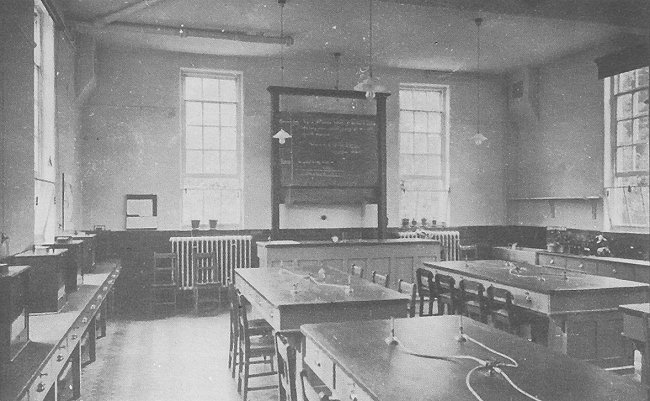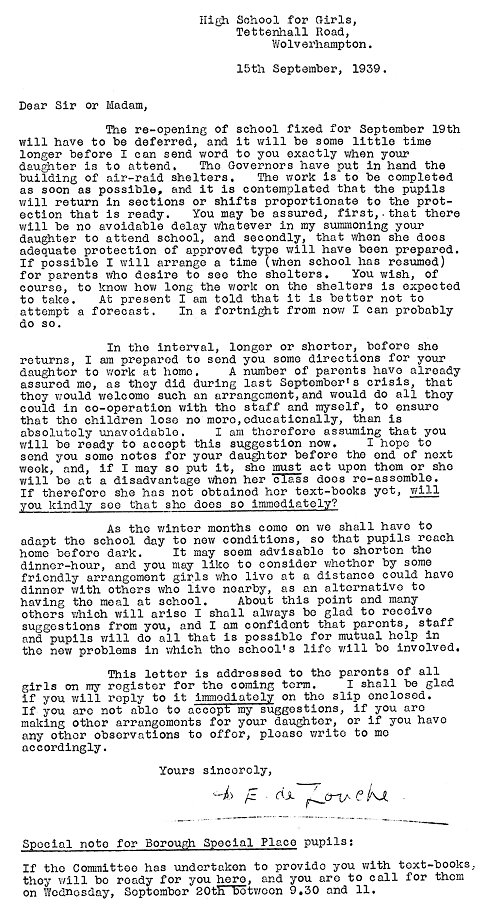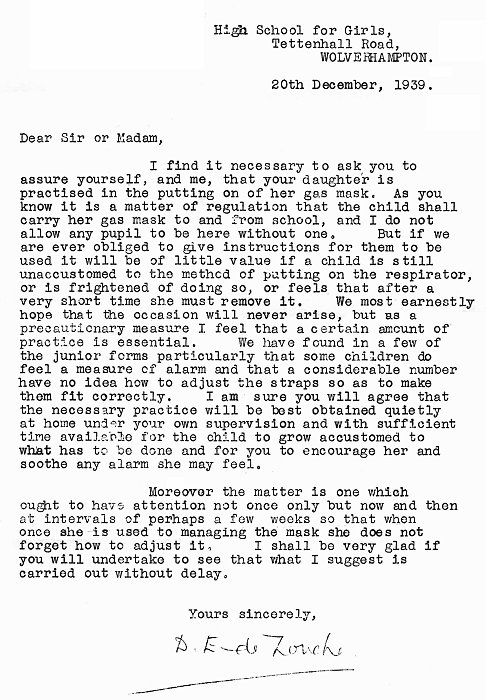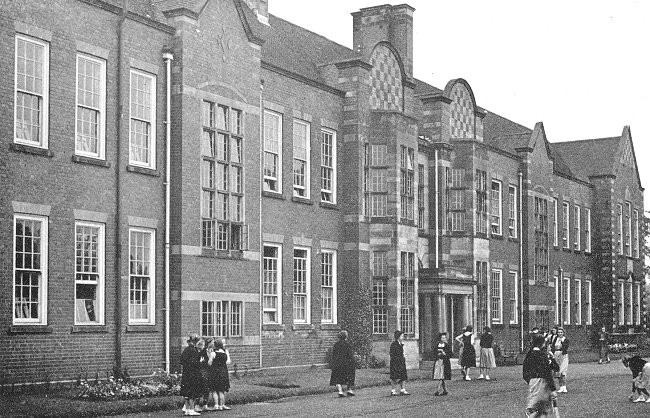|
 |
|
School Library
Many old pupils will fondly remember
the library, an important room for study, with its oak
furniture and well stocked shelves. There were two long
tables in the centre, usually occupied by the more studious
girls, and round tables near the windows where pupils could
easily be distracted from their studies by the view across
the beautiful playing fields at the front of the school.
The original library eventually became
too small for the expanding school. Extra books were needed
for the growing number of sixth forms, and so when the old
Ferrers-Stafford cloakrooms were converted into sixth form
rooms, one of them became a sixth form library, and was
known as the Lower Library. The walls were partly lined with
book shelves, and the room doubled as a lower sixth form
room. The new library had a periodicals section that
included newspapers such as The Guardian, and magazines
including The Illustrated London News, The New Scientist,
The Reader’s Digest, and French and German periodicals.
The old Paget-Audley cloakrooms were
also converted into form rooms. One of them housed a small
library for the 11 to 14 year olds.
Music and Drama
From the early days the first forms had
a short music lesson daily, and the other forms had two 40
minute lessons each week. There were inter-form singing
competitions, and an annual carol concert. Piano and violin
lessons were given by a member of the teaching staff or by a
visiting teacher. The school orchestra began in 1927,
greatly helped by the efforts of Miss Fitzgerald who taught
the violin. The orchestra played at a few choral concerts,
and for a mass gym display in 1932, but rapidly declined
when Miss Fitzgerald left the school. It started again in
1948 and went from strength to strength.
The school’s Choral Society began
giving concerts in 1918. All the girls except first and
second formers were eligible to join. Since 1937 the society
included male singers, who were recruited from the parents.
By 1960 there were 112 members including about 20 male
parents. The first and second formers could join the Junior
Choir, which by 1960 had around 60 members.
House plays began in 1948 and took
place every two years. Each house selected a one-act play
which was scrutinised by an outside adjudicator. The girls
undertook all aspects of the production, including stage
management, costumes, and scenery. The interest in school
drama spread to all age groups, and in 1959 junior house
plays began.
The Senior Dramatic Society began
presenting plays to the whole school, initially in the
school hall. Their last production there was a version of
‘The Rivals’ in 1950, which was very popular. Unfortunately
the stage in the hall was too small for large productions
which needed a large cast. In 1954 the society’s next
production ‘Iphigenia’ was held in the Wulfrun Hall, as were
two other productions; ‘The First Born’, and ‘Dido and
Aeneas’. Because the plays were so successful, the Parents’
Guild decided that a fully equipped school stage was a
necessity. It was to built as part of the school’s Jubilee
celebrations in 1961.
There was also a Junior Dramatic Society which presented
some excellent plays in the school hall, including
‘Everyman’, ‘The Tall, Tall Castle’, and ‘Noah’, followed in
1961 by a version of ‘Toad of Toad Hall’. |

A science laboratory.
|
In the early years of the Second World
War, the Luftwaffe was a constant threat, and so air raid
shelters were built in the front field. At the beginning of
the school year in September 1939, the girls worked at home
until the air raid shelters were built.
On their return, air
raid drill had to be practised. The sound of the electric
bell meant one thing, leave school and head for the
shelters, which were often several inches deep in water,
during wet weather. The electric bell was replaced by the
ship’s bell from the steam merchant ship, ‘Port Hardy’ which
had been sunk by a German U boat in April 1941. Luckily the
shelters were not often used.
Gas masks had to carried, and because
of rationing and shortages, school dress was more relaxed.
Stockings were no longer compulsory, and blouse sleeves
could be shortened.
Because of the shortages, domestic
science was restricted, mainly to theory. Any garments or
dishes created, had to be used. Waste couldn’t be tolerated.
During the war there were no gardeners looking after the
grounds, so the girls planted peas and potatoes, which
were all put to good use.
|

A letter sent to pupils at the
start of World War 2. Courtesy of Ralph Hickman. |
|

A letter sent to pupils about
gas masks. Courtesy of Ralph Hickman. |
There were visits to children’s
concerts in the Civic Hall, and also to the Memorial Theatre
at Stratford-upon-Avon. The winters of 1940 and 1941 were
severe. There were heavy snowfalls and so some of the senior
girls had to clear a path down the drive, using hockey
sticks because of the lack of brooms. The event that had the greatest impact
on the school at this time was the 1944 Education Act when
the school became a grammar school, although it retained its
original name. Fees were abolished, and entrance depended
upon the results of the eleven plus examination. |
|
The Late 1940s
After the war, several alterations were
made to the school buildings. The cloakrooms were moved from
the front of the building to be near the toilets. The former
Ferrers-Stafford cloakroom became a second library, and two
sixth form rooms. The former Audley-Paget cloakroom became a
craft room, and a junior library.
|

Part
of the Lower VI form taken on the steps of the school in
1947. Courtesy of Ralph Hickman.
Back row left to right:
|
| In 1948 the school acquired its third
head mistress when Miss D. E. de Zouche retired, and was
replaced by Miss R. E. Scargill, M.A. |

A school corridor.
|
The 1950s
The school arranged many holidays
abroad for the pupils. As early as Easter 1928 a party of
twelve girls and Miss Griffith went to Paris, and in 1932 a
number of pupils went on a Mediterranean cruise and visited
Portugal, Gibralter, and North Africa. In between 1950 and
1961 nearly 400 girls visited countries including
Norway, Austria, Holland, and North Africa. The favourite
destination was Switzerland, with visits to the Bernese Oberland, Grindelwald, Kandersteg, Leysin, and Berne. There
were also steamer trips on Lake Lucerne, and Lake Geneva.
The 1960s
Work began on a new dining room and
kitchen, new changing rooms and showers, a new cloakroom and
toilet, all sited beyond the old geography room which was to
become the domestic science room. The old domestic science
room was to become the art room, complete with a kiln for
pottery. The old art room then became the geography room.
The building work also included two new laboratories that
joined the hall and the laboratory wing.
The school had a great impact on the
pupil’s lives. Many of them kept in contact long after their
departure. In 1960 to celebrate 20 years of meetings, a
group of old girls went to the Stratford Memorial Theatre to
see ‘The Taming of the Shrew’ followed by a meal.
In 1961 the school celebrated its
fiftieth birthday with a Jubilee Gala. Speech Day was held
in the Civic Hall on 7th February, and attended by many
guests including Miss D. E. de Zouche. There were songs by
the Choral Society, accompanied by the School Orchestra,
speeches about the school’s past, and many old friends to
meet. On the evening of the 21st March a fashion show was
held in the Civic Hall that was attended by the girls, their
parents and friends. On the 19th and 20th April the Senior
Dramatic Society performed ‘Tobias and the Angel’ in the
Wulfrun Hall. It was the society’s most successful play.
On Saturday 6th May there were two
events. In the morning a staff reunion was held at the
school, and in the evening the Old Girls had a celebration
dinner at the Victoria Hotel. A Jubilee party was held at
the school on 18th July. Six hundred girls came along and
were treated to treasure hunts, a concert, and a personal
visit by Cliff Richard and the Shadows. There were sporting
events including athletics, flower pot and slow bicycle
races, relays, and high jumps. The sporting events were in
the form of a House competition which was won by Paget
House. Other events included a fashion show, and
entertainment by a conjurer.
The last event was the Jubilee Service
held on 28th September at St. Mark’s Church. It was attended
by all the pupils and representatives from the many
organisations that have contributed so much to the school.
Also present were the School Governors, the Parents’ Guild,
and the Old Girls’ Union.

Since those days the school has gone
from strength to strength, and in 2015 it outperformed all
other local secondary schools. Its reputation is second to
none, and places at the school are eagerly sought after. It
has a bright future ahead, and hopefully will continue to be as
successful in years to come. |
 |
Return to the
previous page |
|